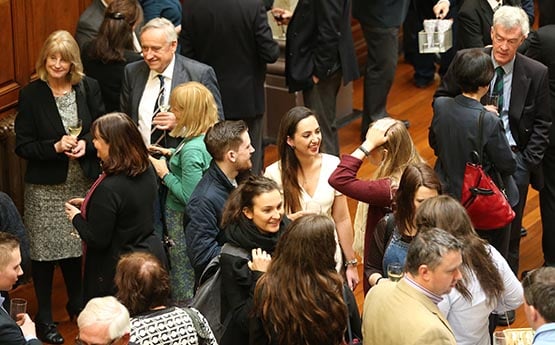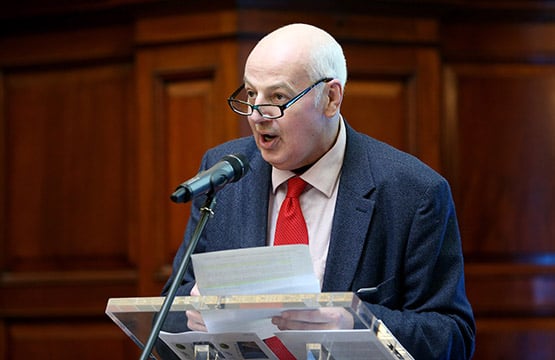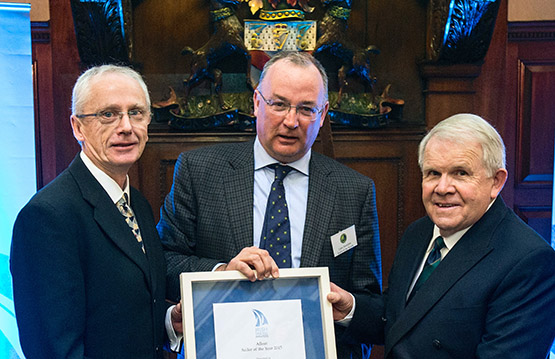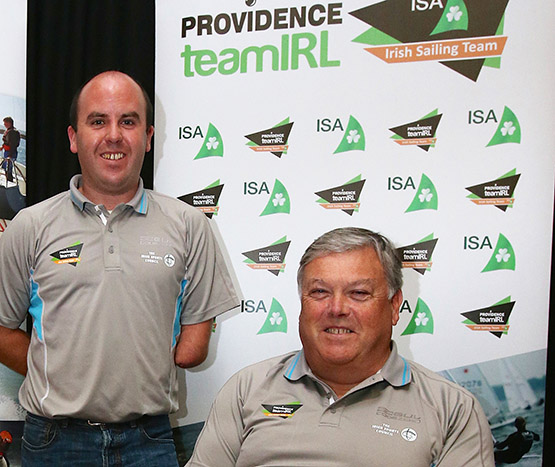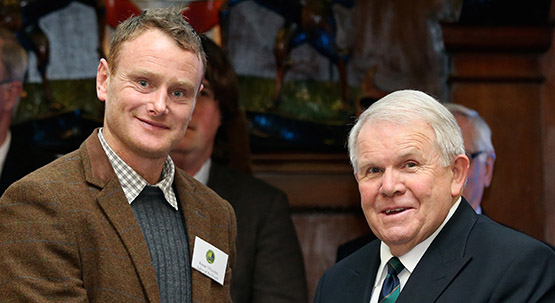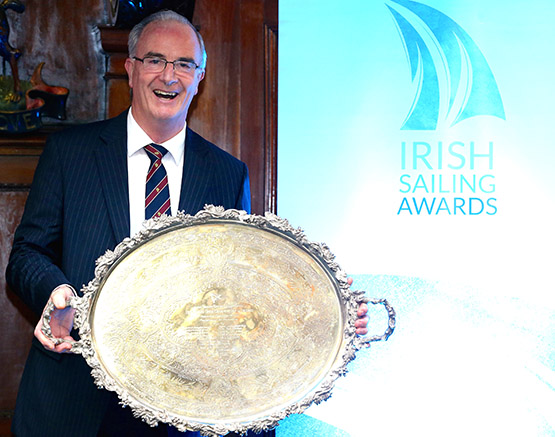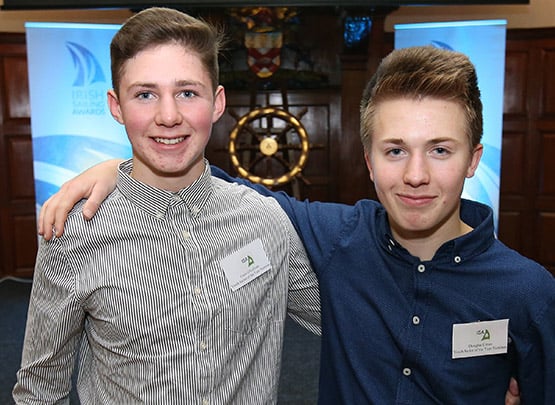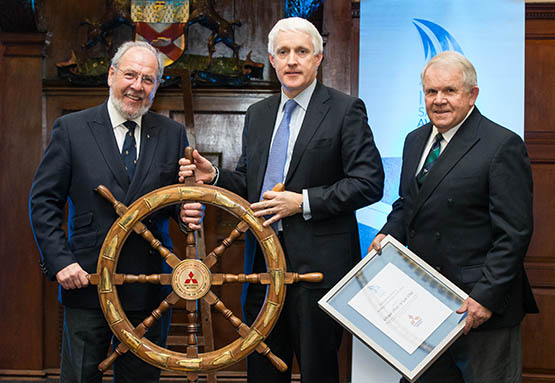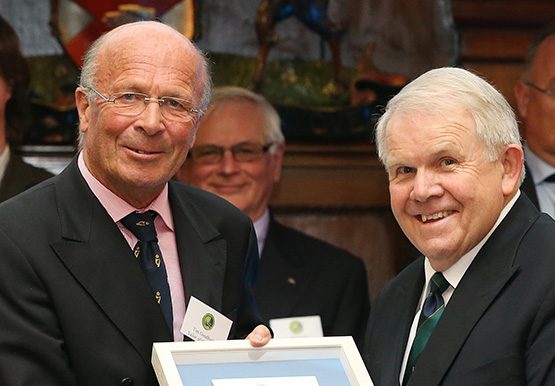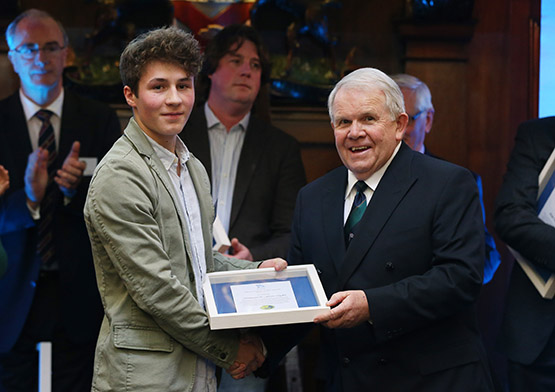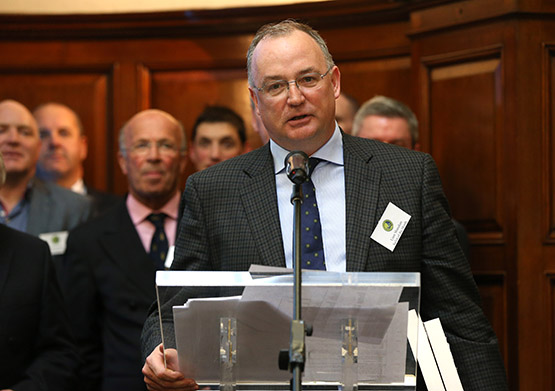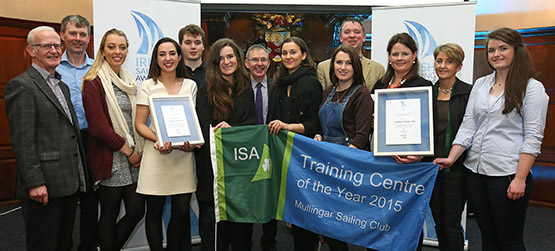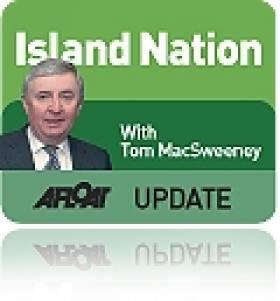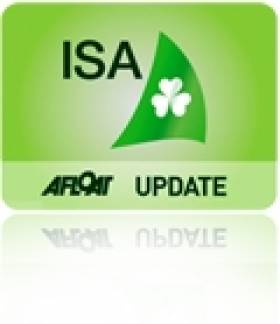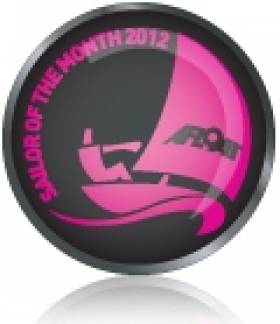Displaying items by tag: Brian Craig
Ireland’s Fireball Dinghy Class Provided The Secret Of Eternal Youth
You’ll have glimpsed the photo gallery and heard the reports of the International Fireball Dinghy Class 50th Anniversary Irish Reunion last Saturday night in the Royal St George YC in Dun Laoghaire. Fifty years, by George……Most sailing folk still think of the Fireball as a fresh and unique off-the-wall sailing phenomenon, a crazy European take on the skimming-dish scows of the lakes of America’s mid-West. And we think of these very special racing dinghies as being something as new as tomorrow, ingenious boats for ingenious owners who like to do all sorts of personal tunings and tweaks to their pride-and-joy. So it brings us up short to find them celebrating their Golden Jubilee. W M Nixon gives his own take on the Former Fireball Fanatics.
If you’re from anywhere well outside the bubble which is southeast Dublin, you’ll assume that a group of guys who regularly drink in a place called the Tramyard will be a bunch of winos. But those in the know are well aware that the Tramyard in Dalkey is a more-than-agreeable coffee house where a regular group of morning habituees supping the essence of the sacred bean is a gathering of sailing friends who have been mates since studying in college or whatever they were doing at that exciting time of life, when all things were possible, and just to have an idea was enough to have the energy to implement it and do something with the result.
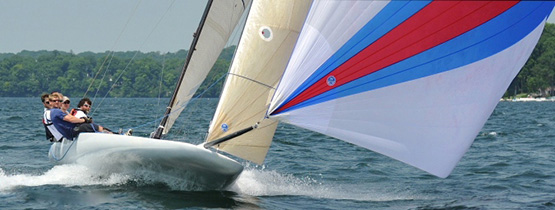
The inspiration for the Fireball design more than fifty years ago came partially from the classic scows of the lakes of mid-western America. This is a Melges Class A Scow.
As this Tramyard crowd have been regularly together for so long, they have not noticed the effects of the passing of the years on each other. So when Derek Jago got to reflecting among them last Autumn that maybe their best sailing years were spent in the Fireball Class, and that it was amazing to think it had been around for fifty years, former Fireball champion Brian Craig immediately suggested that if Derek would organise a post-50th Anniversary Reunion of the Irish Fireball Class past and present, then he – Brian - would see about making the Royal St George Yacht Club available as the venue, for after all it was the George – home club for most of them - which had the biggest Fireball fleet in the great days of the class’s Irish glory.
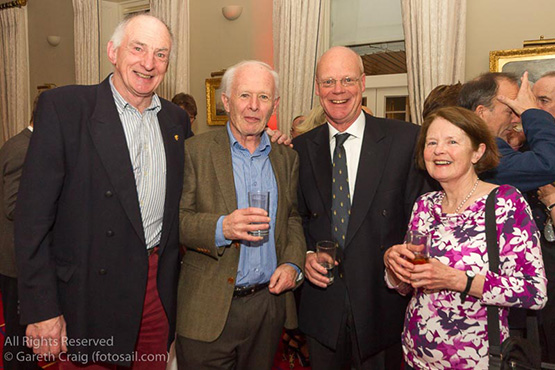
The party happens – Derek Jago (left) with former Fireballers Howard Knott, Peter Stapleton and Hilary Knott. Photo: Fotosail
Of course, when you do organise something like this, you will know what your own close circle of old friends now look like. But it’s a fascinating exercise in the observation of the aging process to wheel in people you mightn’t have seen in thirty and more years.
In fact, it might have been fraught with a certain risk of non-recognition of faces from the distant past. But the Irish Fireball Class was not only an outstanding success in its peak years, it went on to send out rising stars who were to make their mark in many other areas of sailing. Consequently last Saturday night proved to be a gathering of familiar faces of whom, in some cases, folk were saying: “But I never knew you were ever a Fireball sailor”.
Yet not only were they Fireball sailors once upon a time, but they were very proud of the fact. For in the nicest possible way, the Fireball was and is a bit of a cult thing. She was designed by Peter Milne, who at the time of her creation was working on the drawings for the latest Donald Campbell world water speed record challenger. In the midst of such a hothouse of technology and massive expenditure, it seemed like a breath of fresh air to take a little time out to create a boat which reduced sailing to its absolute essentials, and he did it so well that Peter Milne thereafter never quite matched this one divine inspiration.
And it was truly inspirational. After all, who would have thought that a minimalist boat, with just about zero freeboard and skinny with it, and with her slim hull further reduced in volume by having a cut-off pram bow, who could have thought it would be such a superb sailing machine when she’d a crew who gave total commitment to the concept and realized that the use of the trapeze was what Fireball sailing was all about?

The first in Ireland –Roy Dickson’s No 38 making a tentative visit to Dun Laoghaire in September 1962.
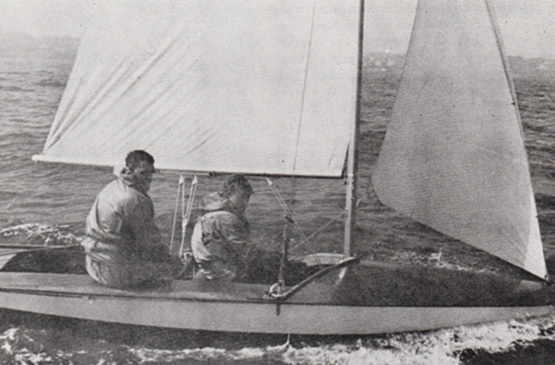
Champions – Roy Dickson crewed by David Lovegrove after successfully defending the Fireball Nationals in 1966.
Well, the first in Ireland was Roy Dickson of Kilbarrack and Sutton on the north shores of Dublin Bay, a man who cannot contemplate any boat without thinking about ways of improving it. He’d already been taking several sails on the wild side by building a Jack Holt-designed 16ft Hornet with a sliding seat in the manner of Uffa Fox’s famous sailing canoes, so when the design of the Fireball first appeared in Yachts & Yachting magazine in 1962, it was a eureka moment.
Roy’s first Fireball, no 38, made a tentative appearance across Dublin Bay in Dun Laoghaire at the end of the 1962 season, and next Spring it was revealed that other sailors from the north shore were following in his footsteps. They’d already set up a class association with Peter O’Brien as Chairman and Eddie Kay as Honorary Secretary, and it was expected that up to 20 Fireballs would be racing in Ireland by the end of the 1963 summer.
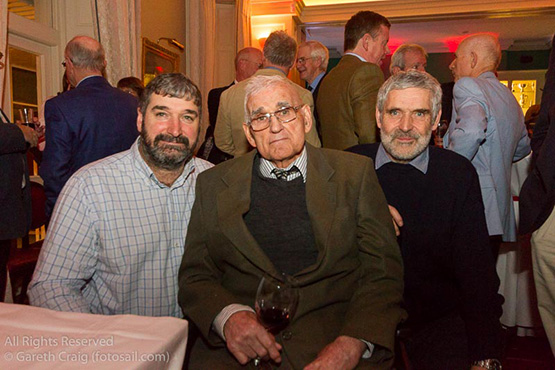
The founding father – Roy Dickson with his sons Ian (left) and David on Saturday night at the celebration of the Irish Fireball Class. Photo: Fotosail
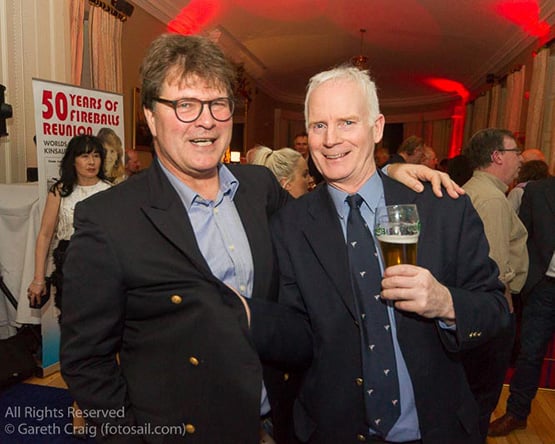
Jan van der Puil (left) with 1995 World Champion John Lavery. Photo: Fotosail

Early days – at an IYA Easter Meeting in Wexford the new Fireballs cut a dash by comparison with the older IDRA 14 and Enterprise in the background. Photo: W M Nixon
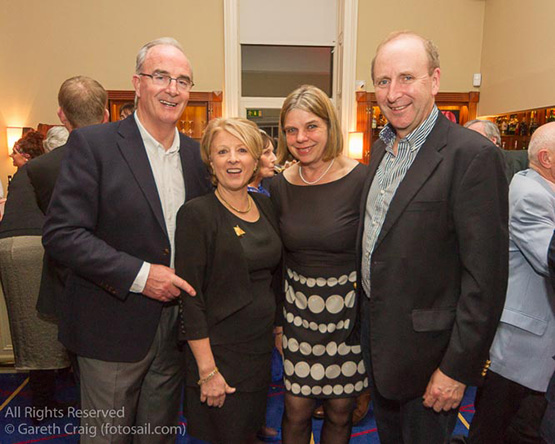
Celebrating the Fireball – Anthony and Sally O’Leary, with Cathy McAleavey and Con Murphy. Photo: Fotosail
It was an extraordinary breakthrough, the memory of it all made even more vibrant by the fact that Roy Dickson himself was there in Dun Laoghaire last Saturday night, his innovative Fireball years recalled as just another chapter in his own fantastic sailing career, which has gone right to the top both inshore and offshore.
The Fireball spoke eloquently to several successive waves of Irish sailors, and in the period between the mid 1960s and the late 1990s, you’d be hard put to say just what was the key year, with an early dose of extreme excitement being the Fireball Worlds at Fenit on Tralee Bay in 1970, John Caig from England being the winner. For although an unmatched high was reached in 1995 when John Lavery and David O’Brien of the National YC won both the Europeans and the Worlds in a mega regatta staged by their home club on Dublin Bay, at other times Adrian and Maeve Bell from the north – they were with Lough Neagh SC at the time - were very much in the international frame, counting many major titles.

Fireballs on an early outing to Sligo, where the Worlds were staged in 2011.
As for staging Fireball World Championships, Ireland has stepped up to the plate four times, with a particularly epic Worlds in Kinsale in 1977 where the Godkin brothers set the pace in the local fleet. Then there was the glorious home win at Dun Laoghaire in 1995. And the most recent Worlds in Ireland were at Sligo in 2011, where the great Gus Henry may have been best known as a stalwart of the GP 14 Class, but he too is a top sailor who savoured the Fireball experience.
At the height of the class’s popularity, nearly three quarters of the boats in Ireland were said to be an own-build, and Roy Dickson was the pace-setter in innovation. It’s said that if Roy turned up at a major international regatta with some completely new but barely perceptible additional feature on his boat, by the next championship you could be reasonably sure that at least half the fleet would have copied him.
But for some years now the class has seen plastic boats in the ascendant, which restrains the innovators. And numbers in Ireland are admittedly no longer so spectacular, for in its top years the truly active Fireball fleet here numbered 70 boats, which for an out-and-out performance dinghy was quite something.

There’s still as little bulk to the boat as possible, but they’re now built in GRP, as seen here with Frank Miller's boat at the Volvo Dun Laoghaire Regatta. Photo: VDLR
Yet while the fleets are reduced, the memories if anything are stronger than ever. The photos reveal the calibre of the people who were and are involved in Fireball racing in Ireland – it’s a national Who’s Who of sport afloat. And if that weren’t enough, the roll call of those who preceded John Lavery and David O’Brien in the intense battles to win the World Championship is of truly global stature in international sailing.
The first one of all in 1966 was Bob Fisher, no less, crewed by Richard Beales. Then Steve Benjamin of the US was in fine form in the 1970s, as he won in ’76 and then defended successfully at Kinsale in 1977. But in 1978 at Pattaya in Thailand, a new name came centre stage – the one and only Lawrie Smith. Then in 1981 the Worlds winner was future top dinghy designer Phil Morrison, with Fireball mods and tuning worthy of Roy Dickson.
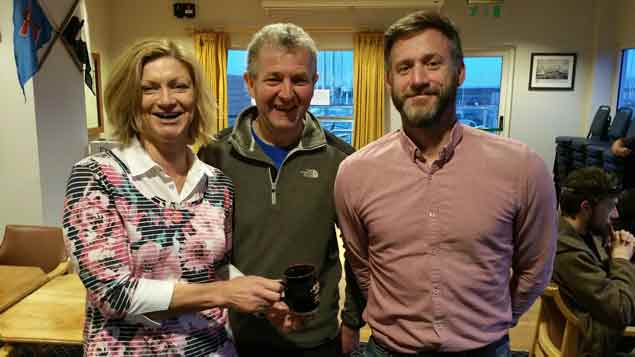
Current Irish Fireball Class Chairperson, seen speaking at last Saturday’s party, is Marie J Barry. Photo: Fotosail
In 1994 it was ace sailmaker and multi-champion Ian Pinnell who won the Fireball Worlds, and this set the bar high for John Lavery and David O’Brien in Dublin Bay in 1995. Faced with the challenge, they implemented a rigorous two-year training and competition programme in the countdown to the big one, and it all came out as planned.
As the Fireball Worlds 1995 were staged in September, the rest of the Irish sailing community were well home from holidays and back at the day job, so those driving home from work on the Friday night heard it on the car radio as one of the top stories on the evening sports news. Ireland had won a world title. Better still, it was in sailing too. And it was on the peaktime national news. It was a moment to be recalled and savoured many times in Dun Laoghaire last Saturday night.

We can always use a cover like this – welcome news with David O’Brien and John Lavery from the Sept/Oct 1995 Afloat.
See full Fireball 50th photo gallery by Gareth Craig of Fotosail here
Irish Sailing Celebrates the Best of the Best
The Irish Sailing Association Annual Awards ceremony undoubtedly conveyed three clearcut messages. The first is that, in global sailing terms, we’re a wet and breezy little island which nevertheless punches way above our weight. The second is that we live comfortably with a long and very distinguished history of recreational sailing which puts most other nations in the shade. And the third is that Ireland is definitely not the greatest place in the world to be a professional sailor. W M Nixon takes a look back at Thursday’s annual prizefest.
Those unfamiliar with the Royal College of Surgeons in Ireland might think it odd that, in just two short years, its splendid College Hall, at the very epicentre of Dublin on Stephens Green, has come to be seen as the most natural focal point for the annual honouring of our top sailors and clubs.
The College Hall in the RCSI provides an ideal setting for the annual gathering for Irish sailing’s national awards.
Sailors talking about sailing. The Awards Ceremony provides a cherished opportunity for sailors from every discipline to shoot the breeze together.
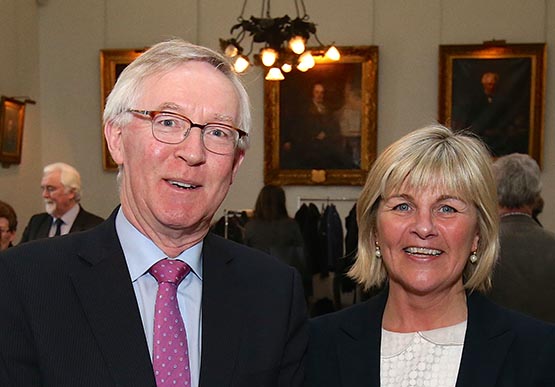
Dragons Den star Bobby Kerr – a sailing man himself – was the lively Master of Ceremonies
But in terms of being a setting which lends itself very positively to such a gathering, College Hall is right on target. It’s a splendid room which is confident with itself without being over the top. It comfortably accommodates the crowd of between 180 and 200 who have come from all over Ireland to celebrate what’s best in our sailing. And as if that weren’t enough, the RCSI has remarkable links with sailing going back more than a hundred years.
John Treacy, CEO of the Sports Council, with Liam Shanahan and ISA President David Lovegrove
So after last year’s first use of the venue, which stemmed from a typically far-sighted suggestion by ISA Board Member Brian Craig, people were keen to go back. And it wasn’t because no-one could think of anywhere better. On the contrary, it was because we’d found that the College of Surgeons is one of those wonderful buildings which make you feel better just from being in it. So in the early days of Spring when we wonder if summer is really going to come at all, a bit of a party in the College of Surgeons is just what the doctor ordered. And as for those doctors and surgeons from the RCSI going sailing, we’ll return to that at the end of this piece. But what of the event itself?
Well, with the Afloat.ie Sailor of the Year award going to a determinedly Corinthian skipper who cheerfully admitted that there’s any amount of professional sailors out there who could probably beat the pants off him, but nevertheless his core interest is offshore racing with family and friends, and if they win within those self-imposed limitations, then so much the better…..There it was, the real voice of Irish sailing, and no mistake.
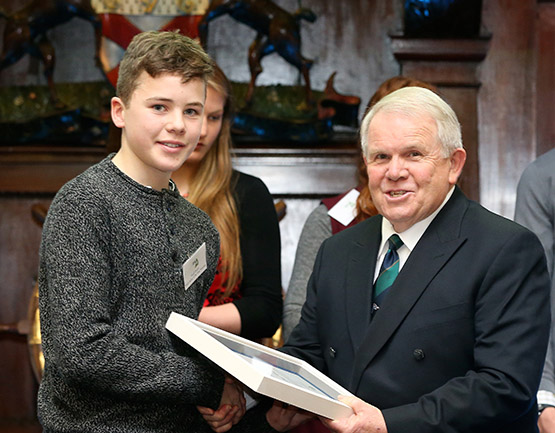
Pierce Purcell of Galway Bay SC with the RIYC’s Michael Boyd, Commodore of the Royal Ocean Racing Club
But what about the clubs through which we go sailing? How can they carry such a wealth of history, and yet be of any contemporary relevance? Here again, the evidence speaks for itself. The new Mitsubishi Motors Sailing Club of the Year has a wonderful history going back to 1831, yet in terms of sailing achievement and voluntary input into the local, regional and national organisation of sailing, it is making a fantastic contribution. And as for its relevance to sailing in the future, independently of the Club of the Year adjudication taking place, this same club was comfortably on its way to being the top ISA Training Establishment in its region, and on the shortlist for the national title too.
Olympian and rising stars – James Espey, Aoife Hopkins and Saskia Tidey
If that’s not an illustration of the way that Irish sailing honours its past while living in the present and looking to the future, then I don’t know what it is. But what’s this third point about Ireland being a cold place for professional sailing? Here again, the assembly in the RCSI was very representative of our Irish sailing population. For sure, there are some very distinguished Irish professional sailors, and there are certainly Irish owners who are prepared to pay the top talents to sail with them. But there’s something about the Irish sailing scene which is inimical to such a setup at home. By all means do it where the weather’s usually benign, and there’s lots of money floating around. But in the Irish climate you sometimes have to be so keen to go sailing despite hostile weather that you just have to rely on nutty amateur crew - the professionals know there’s much better and more reliable pickings elsewhere.
Thus we’ve come to the ironic situation that our top home-based professional sailors are actually our Olympic hopefuls. It’s extraordinary when you think that the modern Olympics were “re-founded” in 1896 in order to celebrate amateur sport, yet now in Ireland just about the only home-based sailors who can be said to be professional are the Olympic aspirants. And if they haven’t accepted that they need a professional approach, then they’re not really at the races at all.
Thus although the friendly Olympian presence of Annalise Murphy, James Espey and Saskia Tidey was much to be welcomed in the very representative throng, generally anyone who was there with any sort of a professional interest in sailing had it as part of a larger business in which actually going sailing is only a small part of the total setup.
Paralympic sailors Ian Costello and John Twomey
Admittedly we did have one Olympian who received an award, John Twomey who took the title in December for his qualification for the Paralympics in September 2016. And he came with added laurels, as on the very day of the ceremony, it had been announced that he and his crew of Ian Costello and Austin O’Carroll had moved up to fifth in the World Rankings. But if you suggested to John Twomey – headed for his 11th Olympiad – that he’s a professional sailor, he’d be convulsed in mirth. Real life is related to an accountancy practice in Kinsale.
So the only other monthly awardee who could remotely be said to be a professional sailor was August winner Ronan O Siochru. who skippered the winning Irish Offshore Sailing boat Desert Star to victory in the 33-strong Sailing Schools Division in the Rolex Fastnet Race 2015. But he’s very definitely running a business - and a very demanding one at that – in which going sailing is only part of it.
Ronan O Siochru with the President
Thus what Thursday’s ceremony was all about was voluntarism and amateur sport, and in case anybody missed the point, it was supposed to be a bit of fun. In this spirit, the greatest trophy in Irish sailing, the might salver for the Helmsman’s Championship, was given an outing. The All Ireland Helmsman’s Championship being an amateurs-only affair, as it is held over an October weekend, inevitably by the time its award ceremony for the salver is shaping up it’s well into Sunday evening. It’s getting dark, and everyone’s tired and wants to go home. So inevitably the handing-over of the historic trophy is a downbeat and somewhat rushed affair.
But as the ISA Annual Awards ceremony is all about handing over prizes with as much ceremony as possible, it was arranged for the salver – which had been hurriedly handed over to successful defender Anthony O’Leary in Dun Laoghaire back in October – to be smuggled out of the O’Leary household down in Crosshaven, secretly taken to Dublin, hidden away in the College of Surgeons, and then formally presented as a surprise extra to the great man after he’d received his Sailor of the Month award for April. He blushed.
Got him! Sailor of the Year 2014 Anthony O’Leary unavoidably missed last year’s awards ceremony, and then in 2015, although though he was Sailor of the Month for April, there were very few people around in October when he successfully defended the Helmsmans Championship Salver. So it was taken secretly to this week’s ceremony, where more than 180 people cheered him to the rafters.
ISA Youth Champions 2015 are Colin O’Sullivan and Doug Elmes, Bronze Medallists in the 420 Worlds.
Before all this, we’d been setting the scene with the ISA Youth Sailors of the Year, who were 420 Worlds Bronze Medallists Douglas Elmes and Colin O’Sullivan, and the ISA Training Centre of the Year, which was Mullingar Sailing Club from Westmeath which headed the Western Region, and overall came in ahead of Foynes YC from the Southern Region and the Royal Irish YC from the Eastern Region.
Katie Johnston of Mullingar Sailing Club with David Lovegrove when MSC was announced as ISA Training Centre 2015.
The new Mitsubishi Motors Sailing Club of the Year is the Royal Irish YC – Commodore James Horan with Billy Riordan of Mitsubishi Motors and David Lovegrove.
But for the RIYC Commodore James Horan, the good news was only beginning, as his club was then announced as the new Mitsubishi Motors Sailing Club of the Year for a host of excellent reasons. We’ll list them in more detail here on Afloat.ie in due course when the traditional handing-over ceremony for the old ship’s wheel trophy is held in the RIYC clubhouse later in the Spring. But meanwhile on Thursday we saw ample reason for it, as two of the Sailor of the Month awards went to very active RIYC members, George Sisk and Tim Goodbody.
July Sailor of the Month George Sisk with the ISA President
Dun Laoghaire Regatta Week 2015 Chairman, Fastnet Race 1987 overall winner, and multiple champion Tim Goodbody was Sailor of the Month in November
Youngest cruising award winner was Fergus Ogden, who in June and July sailed round Ireland with his brother in an open Drascombe Lugger.
Then came the Sailor of the Year announcement. Anyone who was following the voting in the Afloat.ie poll will know it was running very close. But as the poll results are only a quarter of the adjudication process, it was just a couple of days ahead of the awards ceremony when the judges finally made their decision. They came down in favour of Liam Shanahan both for his wonderful and very sporting victory in the Dun Laoghaire to Dingle Race with his family’s J/109 Ruth, and his subsequent success in retaining the Irish Sea Annual Championship title.
His modest acceptance speech was, in effect, a manifesto on behalf of all Irish amateur sailors, and particularly family sailors. The Shanahans are one remarkable sailing tribe right through three generations. And as for that win in the Dun Laoghaire to Dingle Race – well, it was beautiful sailing. Some sailing races are won by brutal slugging. Some are won by sheer cunning. Some inshore races are even won by dirty sailing, and it’s within the rules even if it does the image of our sport no good at all. But some race wins are simply beautiful sailing. And Ruth’s success in Dingle was definitely in that category.
After receiving his award, Liam Shanahan briefly but eloquently outlines his philosophy of sailing
So the ceremony on Thursday concluded with this celebration of the best in Irish sailing, and it chimed well with the mood of the moment and the location, as the current President of the RCSI is Declan Magee who sails from Dun Laoghaire, and he was most welcome at the party and naturally thanked for the use of the hall……
Then as we exited the College Hall, the first doorway we passed was the Sir Thomas Myles Room. He was RCSI President 1900-1902, a wonderful surgeon and a man of prodigious energy who boxed to championship level, and adored sailing. A Home Ruler of Limerick origins. he made his auxiliary ketch Chotah available to take the guns off Conor O’Brien’s Kelpie during the Asgard gun-running of 1914, and landed them in Kilcoole in County Wicklow. And though he was immediately made a Colonel and head of British army surgical services in Ireland on the outbreak of the Great War of 1914-18, he also saw to it that hidden rooms in the major Dublin hospitals under his control were available to treat wounded rebels, indeed anyone who was wounded, during the Rising of 1916.
Builders of the future – the team from Mullingar Sailing Club, ISA Training centre 2015
More recently, a leading sailing figure with links to sailing is Michael O’Rahilly who, when he became a student at RCSI at the end of the 2950s, found that the RCSI Sailing Club consisted of just one neglected Firefly dinghy. By the time he graduated in 1963, he was Club Captain, RCSISC had three Fireflies in top racing condition, and they were the Irish university champions.
Subsequently he went in to play a leading role in Dublin Bay SC, and was the Commodore for the DBSC Centenary in 1984. He follows in a notable RCSI tradition of sailing and working voluntarily for our sport, as an earlier top sailor in the college had been Jimmy Mooney who played a key role in the development of Irish dinghy sailing, and then went on to be our top Dragon sailor for many years, winning the Edinburgh Cup and representing Ireland in the Olympics.
Before Jimmy Mooney another noted character in the RCSI sailing scene was Rory O’Hanlon, who became a noted figure in offshore racing – he won a cup in the 1971 Fastnet Race – and was further renowned for his long distance cruising exploits.
He was noted as a kindly mentor to young cruising hopefuls, gently giving encouragement which could make all the difference to a nervous skipper. One such beginner, who later went on to great achievements, nervously went to Rory O’Hanlon to ask how best he should approach his first major voyage, north towards the Arctic in a little 26-footer.
“Sure, you just keep on sailing, and you’ll get there” said Rory. “Just keep on sailing, that’s all there is to it”. Just keep on sailing. It’s sensible advice. It resonated round College Hall in the RCSI on Thursday afternoon. We should all heed it.
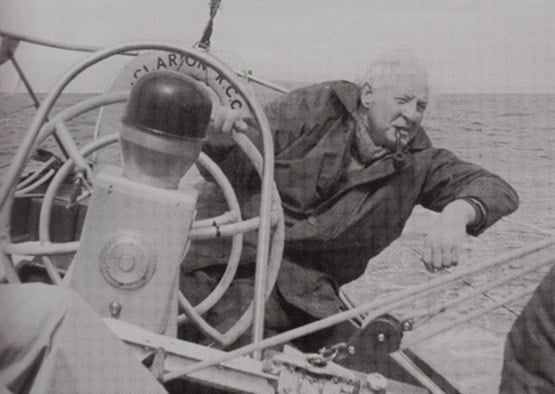
“Just keep on sailing, and you’ll get there”. The late Rory O’Hanlon at the helm of his S & S 43 Clarion with which he won the Philip Whitehead Cup in the 1971 Fastnet Race, and also cruised on long voyages. While a student at the Royal College of Surgeons in Ireland, he was active in the sailing club.
See also: Sailing Awards slideshow
Difficult Waters for Irish Sailing, Just 17,000 Registered Leisure Sailors in Ireland
#irishsailing – There are just 17,000 registered leisure sailors in Ireland at present. There has been a decline in sailing, the level of activity has weakened, clubs are losing membership and several marinas have space available for the first time.
The only official participation figure available is for those 17,000 members of clubs registered with the Irish Sailing Association. There are many more sailors who own boats and use them outside of the club structures, so the actual participation levels could be two or three times that number. But there is no doubt about the decline in activity in the sport. The effects of the economic recession, people having less disposable income, loss of jobs, emigration, have all had their effects.
Brian Craig, one of the Directors of the ISA discusses the challenges facing the sport in a frank and direct interview on the current edition of THIS ISLAND NATION, the niche maritime radio programme, which you can hear here. The interview ranges across the still-present perception of the sport as 'elitist' and the methods needed to change this and to increase involvement in the sport.
"There is still a strong core foundation to the sport," Brian Craig says in the interview which discusses the Strategic Plan the Association has drawn up and which has been considered at meetings of ISA members around the country.
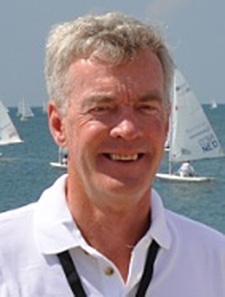
Brian Craig
The plan will be put before the ISA annual general meeting in Portlaoise on March 28 for adoption.
GOVERNMENT THINKS THERE IS AN IRISH LANDBRIDGE!
"We are a funny country. We are surrounded by water. We have a Government that thinks there is a landbridge somewhere, but they don't know where it is."
That was the comment of former seafarer Tom O'Mahony when he spoke to the programme at the annual Remembrance Ceremony for those lost at sea in the town of Youghal on the East Cork coastline. It is a coastal town with a great schooner tradition and memories of seafarers who ranged from the River Blackwater onto the world's oceans in various types of vessels. It is also where the programme is compiled, edited, recorded and transmitted every Monday fortnight at 6.30 p.m. and later each fortnight on Near FM in Dublin, Dundalk FM, Dublin South FM and Raidio Corca Baiscinn in County Clare as well as on this website.
Tom O'Mahony said there was a lack of maritime awareness at Government level and recalled the closure of Irish Shipping and the manner in which ships and crews were stranded overseas and men later left without pensions. "And that was company in which seafarers had gone to sea in ships that would not now pass maritime safety requirements."

DISABLED SAILING
The RNLI describes a very courageous disabled sailor on the programme in contrast to the decision of the Paralympics Committee to discard sailing from its programme.
NO PLACE FOR BEING POSH OR A FIGUREHEAD
Also discussed on THIS ISLAND NATION is the use of nautical descriptions in everyday language, such as 'posh,' being a 'figurehead' and 'flogging a dead horse."
Just Who Do The Irish Sailing Association Think They Are?
#irishsailing – Ireland's national sailing authority has been going through turbulent times in recent years. With unprecedented expansion of ISA staff numbers as the country revelled in the boom years of the Celtic Tiger, the arrival of the inevitable and abrupt financial downturn found an Association bloated, unfit to cope, and out of touch with ordinary sailors.
High profile events, top level training and international participation had become so dominant in the ISA's range of activities that many of the ordinary sailors of Ireland already felt the Association was no longer relevant to their own low key personal pursuit of friendly sport afloat.
When the crash came, it led to a marked decrease in active sailing numbers as disposable incomes fell away. People focused on keeping their jobs and businesses afloat rather than their boats sailing, while many promising young sailors were forced to emigrate.
This new reality was reflected by the growing disillusion of club officers, who saw their membership subscriptions decreasing even while the ISA – which is largely reliant on subvention from the clubs for its own income – seemed always to be looking for more money. And at the height of the boom years, when all the major clubs had put through significant expenditure in developing their facilities to international standards, the ISA had shown its lack of contact with the reality of club life by proposing its own stand-alone National Sailing Centre in Galway, a facility which would in effect have been run in rivalry to the main clubs. To the mutterings in the grass roots were added the rumblings from above as major clubs threatened to withhold their annual payment to the ISA unless real reform was initiated. W M Nixon takes up the story.
In a classic grass roots revolution, club sailors Norman Lee from Greystones in County Wicklow and Bryan Armstrong from Sligo were at first rebuffed when they tried to voice their concerns about the ISA's increasing irrelevance to the needs of the vast majority of sailing enthusiasts, people at local level who were doing their very best to keep the sport alive through torrid times.
The Irish sailing community now owes these two men and their supporters a debt of gratitude, for they believed in what they were saying and they refused to be turned aside. Eventually, in November 2013 moves were in place to establish a Review Group for the urgent analysis of all ISA activities, and its personnel drew comprehensively on Ireland's remarkable pool of people with hands-on experience of running successful sailing events and organisations.
It was chaired by Brian Craig of Dun Laoghaire who has headed up the organising team on more major and notably successful international sailing events in Dublin Bay than probably anyone else, and its able personnel included two former ISA Presidents - Roger Bannon of Dun Laoghaire and Neil Murphy of Malahide and Howth - who had both been noted for their skill in running a tight ship when they were in charge. With them was highly regarded International Race Officer Jack Roy of Dun Laoghaire, and renowned sailmaker/activist Des McWilliam of Crosshaven, who each year is inevitably seen in busy involvement afloat in more Irish sailing centres - large and small - than anyone else in the boat world.
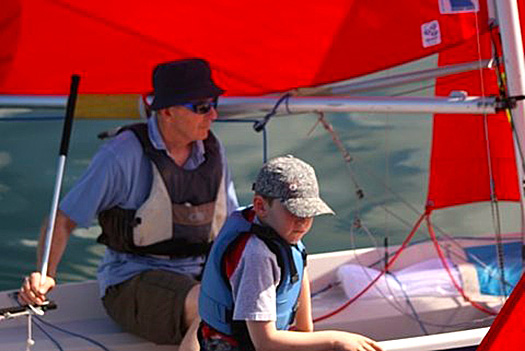
Bryan Amstrong of Sligo on the helm for a Mirror race
Also on board was one of the men from the barricades, Bryan Armstrong of Sligo. His background in a relatively remotely-located club which nevertheless has a long and distinguished sailing history made him uniquely qualified to voice the concerns of the grass roots. And we have to remember that all these people were giving voluntarily and generously of their time to this project in a period when Irish life was largely a matter of just getting through each day, while staying economically afloat was something of an achievement.
Primarily, the Review Group's function was to analyse the Association work on behalf of ordinary club sailors, as it was agreed that the Olympic and High Performance Divisions of the ISA's activities – which receive direct Sports Council grants – were in effect functioning as a different entity.
The Strategic Review Group was still work in progress when the ISA acquired a new President in David Lovegrove in March 2014, but by August the SRG published proposals which led to the setting up of a more formal body, the Planning Group. If this seems like a case of kicking the can down the road, it was anything but - these were people in a hurry, they'd got through the first stage of analysing areas where action was required, now they had to be more structured in coming up with clearcut ideas and concrete proposals.
This new Planning Group, which went into action in early Autumn 2014, was chaired by Neil Murphy, and its members included ISA President David Lovegrove, ISA Board Member Brian Craig, Ruth Ennis, Peter Redden, Sean Craig, and ISA CEO Harry Hermon, with noted Dun Laoghaire events administrator Ciara Dowling to provide administrative support.
They had their draft plan ready by mid-December 2014, and on January 21st 2015 Neil Murphy and his group publicly unveiled their analysis and proposals for the first time at a well-attended and very representative meeting in the Royal St George YC in Dun Laoghaire.
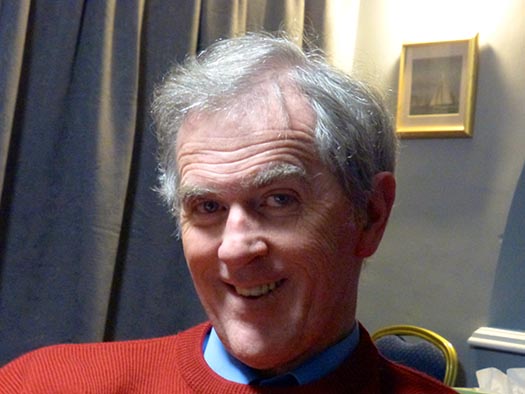 Neil Murphy is a former ISA President who, in addition to extensive experience as a Race Officer, is a typical club sailor, racing a Puppeteer 22 out of Howth. Photo: W M Nixon
Neil Murphy is a former ISA President who, in addition to extensive experience as a Race Officer, is a typical club sailor, racing a Puppeteer 22 out of Howth. Photo: W M Nixon
While those involved in setting the ISA on a healthier course are mostly working on a voluntary basis, it has to be said that the PowerPoint presentation and the printed material was of the highest professional class. In fact, it was much better than many professional shows I've been to, and the level of thought which went into a wide range of questions from the floor answered by Neil Murphy, Brian Craig and David Lovegrove generated a growing level of goodwill which concluded with Norman Lee voicing his congratulations and good wishes for this continuing process in which he and Bryan Armstrong had played such a key role.
So now we move on to the next stage – taking the ideas to the rest of the country. Doubtless you'll have noted the double meaning in titling this piece 'Just Who Do The ISA Think They Are?' In a first interpretation, that question is the one for which, let's hope, we are all now involved in working together in providing and implementing a satisfactory answer.
But equally, as the ISA Road Show gets out of Dublin to take this excellent presentation to a public meeting in Cork next week (it's in the Rochestown Park Hotel on Tuesday, Feb 17th, 7.0 pm to 9.0 pm) and then Galway the week after (Galway Bay Sailing Club, Tuesday 24th February 7.0 pm to 9.0pm), they'll be taking themselves into areas where experience of sailing administration long pre-dates the establishment of organised sailing on Dublin Bay.
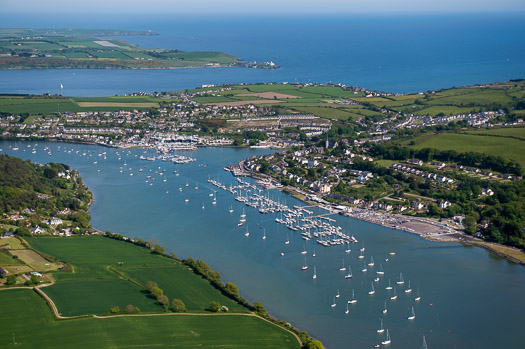 Crosshaven in the summer time. When we look at the natural advantages to be found here, it's little wonder that structured recreational sailing on Cork Harbour long-pre-dated any organised sport on Dublin Bay. Photo: Robert Bateman
Crosshaven in the summer time. When we look at the natural advantages to be found here, it's little wonder that structured recreational sailing on Cork Harbour long-pre-dated any organised sport on Dublin Bay. Photo: Robert Bateman
So you might well ask just just who do they think they are, these people from Dublin, going down to Cork to try to tell them how sailing should be organised? The nerve of them, doing it in a place where they've had organised sailing since 1720, and where the two biggest clubs – the Royal Cork and Kinsale – are both mighty establishments of international sailing repute which would remain so even were the ISA to disappear overnight in a puff of smoke...
And as for going west along the road to Galway, that will take them through Athlone where the Lough Ree Yacht Club dates back to 1770, while on the west coast the Royal Western of Ireland YC at Kilrush traces its origins back to 1828. Equally, further north along the Atlantic coast Sligo YC dates back to 1821, and in Lough Erne the club began in 1820. Yet the first club on Dublin Bay, the Royal Irish, only began as recently as 1831, and even then it barely hung in and had to be revived in 1846, with the pace being set in the meantime by the Royal St George YC, founded 1838.

Kinsale is another harbour which seems to have been designed with sailing primarily in mind. Photo: Kevin Dwyer/courtesy ICC

Kilrush on the Shannon Estuary had a club in being before there were any sailing institutions on Dublin Bay. Photo: W M Nixon
So in terms of sailing administration history, Dublin and Dun Laoghaire are only Johnny-come-lately places by comparison with just about everywhere else in Ireland. Yet thanks to the inevitable dominance of economic development, population growth and the strengthening centres of political power, we now find that sailing administration and decisions of national import are emanating from a place that, in terms of natural sailing advantages, lags far behind the rest of the country.
Oh for sure, Dun Laoghaire Harbour is a fabulous artificial amenity, and the advent of the new marina at Greystones has already been seized upon as greatly increasing the "cruising" options of Dublin Bay. But let's face it, Dublin Bay is really only good for racing, specific day sailing and training, whereas Cork Harbour and Kinsale provide such a variety of opportunities for interesting race courses, mini-cruises with multiple destinations and what have you, that in effect they're not just in a different part of the country – they're a different country altogether.

Dun Laoghaire is a totally artificial facility, and sailing options on Dublin Bay are limited. But it's inescapable that this is the primary point of leisure access to the sea for Ireland's largest and most affluent population. Photo: Kevin Dwyer/courtesy ICC
All of which adds to the difficulties of creating a meaningful national authority with which every sailing person can identify.
This business of Dublin v The Rest is not unique to sailing, of course, but when you have a specialist sport with multiple sub-branches of activity, the problem is exacerbated.
So please bear this in mind if you take yourself along to the meetings in Cork or Galway during the next ten days. This really is a genuine attempt to base the ISA within the sailing community at an everyday level of usefulness to all, with scope for growth while enhancing existing structures, and input from the sailing community at this stage will help in developing the ideas and initiatives proposed.
While the draft ISA Strategic Plan 2015-2020 very definitely puts the emphasis back on to the need for healthy well-run clubs as the basis for the sport, there was initially a feeling at the meeting on January 21st that the new-look ISA is not supportive of commercial sailing schools. In fact, what the new-look ISA hopes to do is encourage training schemes within clubs, while at the same time supporting commercial sailing schools where the demand is such that no club could realistically cope while maintaining its essential club ethos.
Going into this in more detail in a personal meeting this week with Neil Murphy, who is a Chartered Quantity Surveyor, we talked around the fact that a thriving club scene is central to the spirit of Irish sailing, and he was musing on the success of Sutton Dinghy Club where Hugh Gill heads up what is in effect a commercial sailing school within a club setting.
In fact, what Murphy would hope to see emerge at larger population centres is sailing's equivalent of the public golf course. Anyone who has used a public golf course will be aware that the proprietors are usually mustard keen to encourage the formation of a "club" within their customer base, and there is no reason why this shouldn't eventually take root in Irish sailing, providing access to sailing at a fraction of the cost of joining an established club.
It's not something which can realistically be objected to by established clubs trying to protect their own membership, as the people who would use a "public sailing club" would be those who simply couldn't afford to go sailing at all in the current traditional club setup.
Nevertheless support for the established club setup is central to the new Strategic Plan, and the provision of Regional Development Officers to serve clubs directly is very much to the fore in the new thinking. But in looking over the figures published with the report, it's good to note that the ISA works with no less than 80 recognised training centres, while an encouraging statistic is that there are now 24 secondary schools in Ireland which include sailing as a regular part of their curriculum. Admittedly it's a long way from the French setup where every schoolkid is entitled by law to one week of sailing and one week of skiing per year, but in a country where an aversion to being on the water used to be thought inevitable, it's a step in the right direction.
All these considerations of inexpensive sailing are a whole world away from the stories of recent weeks and days about the ISA's High Performance Division seeking a fund-raising executive who will be tasked with finding €2.75 million per annum through philanthropic and other donations in order to help the funding of top level campaigns which we're not allowed to call Olympic campaigns, as apparently that is copyrighted by the Olympic Council, so we call them High Performance instead.
But apparently Government departments aren't restricted by this limitation on the use of the word Olympic, for it was bandied about like nobody's business in this week's news that the government is spending mightily through the Sports Council, with sailing being number three in all Ireland in terms of current Sports Council funding, with a total tag of €1,289,900.
Of course it's not all for specifically Olympic sailing, but it covers 103 sailors from Optimists to the Olympics. Which is fine and dandy for those who are mad keen to race at the highest level, but most sailors in Ireland are much more interested in performing well within their chosen area and boat class, but with sailing being just part of a reasonably civilised and well-balanced life.
And as became evident at the meeting on January 21st, there's an increasing number of people who feel that sailing needs to realise that there's a sizeable population out there of folk who'd like to go sailing, but don't feel the almost religious vocation to own a boat.
With the rapid expansion of sunshine sailing holidays with boats and equipment readily available for hire at the destination, there's a strong feeling there's a real need for more of this in Ireland, even if we can't guarantee the sunshine. The suggestion brings us back to both the "public sailing club" concept, and the growing realisation by established clubs that they have to reach out to potential members by having boats available for sailing on a trial basis.

The Affordable Sailing Team – Norman Lee (right) with his brother Ken beside their campervan at last year's GP 14 Worlds at East Down YC on Strangford Lough. Photo: W M Nixon
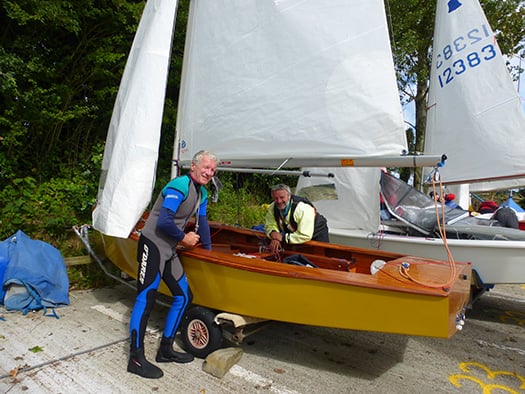
With their own very high can-do standards of boat maintenance, Norman and Ken Lee can keep their GP 14 in the competitive frame. Photo: W M Nixon
That said, the need to own one's own boat and tune and tinker with her to your heart's content is what sailing is all about for many of us, and Norman Lee is a classic case in point for this approach. He claims that his sailing costs him just €600 per year, though that of course is after he has paid for his well-tuned GP14, and he has long since written off the cost of the vintage camper-van which is home to the Lee Equipe when they hit the campaign trail.
Nevertheless the entire setup has to be outstandingly good value, and doing it in such economical style is part of the fun of it all. So when someone with Norman Lee's approach to sailing is prepared to get up at the big ISA public meeting in Dun Laoghaire and congratulate the team who have been working on the reforms which he and Bryan Armstrong set in train, then that is approval of a high order.
And as for just who or what is the ISA, can we maybe agree that ideally we all are the ISA, every last one of us who goes sailing or is even just interested in the sport, and it's up to us to keep it in line and encourage it to identify with and serve the ordinary sailor every bit as much as the high-flyer.

Private pleasure.....the 2014 GP 14 Worlds at East Down YC is about as high as many Irish sailors would expect or want to aim, and many are content with much lower-key regular club sailing. Photo: W M Nixon
2015 Will be 'Pivotal Year' for Irish Sailing Association
#sailing.ie – Irish Sailing Association (ISA) President David Lovegrove gives an update on a fundamental restructure of the organisation
Following the AGM in March 2014, the Board of the ISA received the report of the Strategic Review Group chaired by Brian Craig. In response to its extensive recommendations, the Board initiated a fundamental restructure to re-establish the organisation's relevance to its membership and focus its energies and capabilities on core activities.
Organisational and governance changes have been adopted together with a rationalisation of the professional team, a significant reduction in overheads and the disposal of surplus assets.
These changes allow resources to be re–allocated more directly into providing support at regional and club level and also reflect a change in emphasis from that of largely performing a regulatory role to one of being a source of active guidance at grass roots. This will be achieved within a cost structure which is realistically matched to the existing income profile.
In consultation with the Board and the recently formed Policy Groups, which are a valued source of expert advice on key areas of policy and activities, the Strategic Planning Group under the Chairmanship of Neil Murphy, is developing a new 5 year Strategic Plan 2015-2020. Following consultation with clubs and affiliated organisations in the New Year, this will be presented for consideration and approval at the next AGM in March 2015.
In the meantime, major changes to communications and PR are being implemented with a new website to be launched early in 2015, a collaboration agreement being signed with Afloat Magazine and a newly formatted high profile event, details for which will be announced shortly, that will pay tribute to our sailing achievers at both international and national level.
The training area will see innovative initiatives in 2015 with the launch of an online logbook for the Small Boat Sailing Scheme, the publication of a Junior Organisers' Handbook and the appointment of National Trainers for Sailing, Windsurfing and Power Boating. A Pathway for clubs looking to develop more double –handed sailing at local level for juniors will be finalised in 2015.
The ISA will also focus on developing a structured approach designed to make Coaching resources more readily accessible to sailors of all abilities and interests, including keelboat sailors, and ensure a trickle down benefit from the outstandingly successful High Performance programme.
With a revised and extended structure of Regional/Sailing Development officers, the ISA foresees working much more closely with Clubs, Class Associations and the Irish Cruiser Racing Association to coordinate plans for increased participation levels and sharing of resources. As part of this, it is planned to develop a comprehensive database on racing activities both at Club and at National level. Addressing this lack of information is regarded as key to the development of strategies to enhance and grow racing activity levels.
Cruising represents a large constituency of regular sailors and in consultation with The Irish Cruising Club and other established cruising groups, it is proposed to become more supportive in serving these interests by assisting in organising cruising symposiums, promoting Cruise –in–Company initiatives and providing reliable information on berthing facilities and visitor moorings around the country.
Increasing participation in sailing has long been a strategic objective of the ISA and if club membership and participation levels at many sailing events are an accurate indication of activity, it is clear that a major challenge to be confronted exists in making the sport more accessible and attractive to new participants. We also need to ensure that those who are regularly involved in the sport, but not necessarily as members of clubs, can find cost–effective ways of becoming more formally integrated into our club infrastructure.
During this re–direction of emphasis, it remains a major priority for the ISA to continue delivering its current range of services and competently discharge its responsibilities as the National Governing Body for Sailing.
2015 will be a pivotal year in executing this new direction for the ISA and success will be heavily reliant on the contribution and interaction of all sailors, whatever their interests or needs.
Finally, a big thank you is warranted to the professional team in the ISA and to all the volunteers who have energetically and generously contributed to what has been a very challenging eight months for the ISA.
David Lovegrove,
President
'Independent Group' of Sailors to Form Future Irish Sailing Association Plan
#ISAPLAN – The Irish Sailing Association (ISA) is set for a shake–up following a year of controversy over its policies. Last night it was revealed an 'independent group' – that includes some of the association's critics – has been appointed to form a new plan for the governing body.
In framing the terms of reference for the 'Strategic Review Group' (SRG), ISA President Niamh McCutcheon conceded 'events have overtaken it and the ISA needs a new plan'.
A team of six leading sailors will 'establish the policies to be pursued and the actions required to deliver them successfully', according to SRG chairman Brian Craig, a former flag officer of the Royal St George Yacht Club in Dun Laoghaire.
Some long standing grievances aired last winter led to revolt when sailors Norman Lee and Bryan Armstrong criticised its dinghy and small boat training at the ISA agm. The points raised received widespread support that manifested itself months later in a vocal 'dinghy conference' for Ireland's 20 small boat classes at the National Yacht Club, resulting in over 300 suggestions for change.
It took perseverance and genuine courage to press for this change and there will be many sceptics and spoiling interests to confront if this first step is to translate into a new blueprint for sailing but in forming the new group, Craig has stressed its impartiality: 'As an independent group, we are ideally placed to seek suggestions".
We want to hear from anyone with a view to offer and I assure you that we will listen', he vowed.
Headquartered in Dun Laoghaire, the ISA has a staff of 14. Its accounts for 2012 show a turnover of €2m, much of it made up of government grants.
Significantly, Craig has included former ISA President Roger Bannon, an outspoken critic of current ISA policies in the line–up. A dinghy and sportsboat champion in his own right, Bannon used his term in office two decades ago to secure the position and financial viability of the association as a national sporting authority by making every member of a sailing club in Ireland also a member of the ISA.
It was a bravo move that unified Ireland's sailing clubs into a stronger whole fit to nurture the talent necessary to challenge the world at the top levels of sailing. But in more recent times that fitness has been called into question, and Bannon is among those who hit out at an authority that has arguably lost its relevance to all bar those at the most elite levels in the sport.
In a call for change on Afloat.ie last March, "The ISA has lost its way over the last few years," Bannon said, giving his view of a bureaucracy "detached from the reality of what is going on in the front line".
Craig has also asked another former president Neil Murphy, along with Olympic race officer Jack Roy, sailmaker Des McWilliam and small boat advocate Bryan Armstrong to join this Group, with the option to add others as the process continues.
Once it has carried out an 'initial examination' the group will move on to recommend 'future strategies'.
Spring 2014 is scheduled as completion date for the Group's assessment of the current position.
'This will be a major undertaking but I am confident that, with the support and engagement of all interested parties, we will chart a course for the Sport suited to this new environment.
It is understood the process will include a zero based budget review on key financial areas along with a review of the association's committee structures.
'The new plan will be critical to the association's ability to provide leadership in satisfying the aspirations of existing members and in attracting new participants to the sport', according to McCutcheon, the outgoing president due to step down in March.
The SRG has set up a dedicated email address and can be contacted by email through [email protected]
In a statement seen by Afloat.ie SRG Members are listed with the following bios as:
Bryan Armstrong lives at Rosses Point County Sligo. Keen if not overly successful dinghy sailor since the late 1960s with an interest in home boatbuilding in wood – Mirrors, GP14 and (for the 2011 Worlds in Sligo), a Fireball.
Committee member of Sligo Yacht Club several times over the years and Commodore 1978. Chaired organising group for 2006 GP14 Worlds in Sligo which was intrinsically linked with the construction of the new Sligo clubhouse. Always interested in junior sailing in Sligo and nationally. Committee member Irish Mirror Class Association 2004 to 2011 and President 2008 to 2010. Currently actively sailing a GP14. Practicing partner solicitor in a Sligo based firm. Bryan can be contacted at [email protected]
Roger Bannon, a member of the National Yacht Club, was President of the Irish Sailing Association when the Joint membership Scheme was established and the current Olympic /Elite model was devised in the mid 90's. He has always been a keen small boat sailor and has won multiple national titles in the 420, Mermaid, Flying Fifteen and J24 classes. He was the first Irish sailor to pioneer racing in the Olympic Star Class and more recently was one of the innovators in the establishment of the SB20 fleet in Ireland. He continues to have an active interest in the sport and still regularly sails his venerable 53 year old Mermaid "Endeavour" and when creaking bones allow, occasionally a J70 or a National 18. Roger can be contacted at [email protected]
Brian Craig, a former flag officer of the Royal St George, a member of the Irish Cruising Club, Lough Derg and Kinsale yacht clubs. Was a keen dinghy sailor competing on the Firefly, Fireball and Team Racing national and international circuits. Currently racing a SOD, he has a motor cruiser on Lough Derg and a cruising yacht based in Dun Laoghaire.
Since retiring from business, he has played a key role in attracting and organising major championships on Dublin Bay. He worked closely with the waterfront clubs and local bodies in Dun Laoghaire to develop the biennial Volvo Dun Laoghaire Regatta and more recently led the Irish team that ran the ISAF Youth Worlds 2012.
He was a recipient of the 2010 National Award to Volunteers in Irish Sport from the Irish Sports Council. Brian can be contacted at [email protected]
Des McWilliam (Royal Cork Yacht Club and Royal Irish Yacht Club)
A regular participant in Irish and international sailing. He is in constant contact with customers in dinghy and keelboat sailing - racing and cruising.
Des Sailed for Ireland: Admiral's Cup on five occasions, Sardinia Cup twice, the Southern Cross and 1/2 Ton Cup twice. He is the owner of McWilliam Sailmakers Ltd / UK Sailmakers Ireland and President of 50-loft UK Sailmakers International Group 2010-12. Co-owner UK Sailmakers International Group 2012-present and was a member of the Oireachtas Task Force on Small Business in mid '90's He was a guest lecturer in Entrepreneurship UCC late '90's and is still in business after five years of recession. Des can be contacted at [email protected]
Neil Murphy (Howth Yacht Club and Malahide Yacht Club)
Enterprise dinghies and Laser frostbiting (when wet suits were a novelty) were Neil's intro to the sport. Small boats are still his favourites and he races a Puppeteer 22 in Howth. As a National Race Officer, he gets to see and enjoy racing in a variety of Classes.
As one of the ISA's youngest Presidents (1996 to 1998), he launched its first Strategic Plan, which plotted priorities and set out its targets coming into the current millennium. He chaired the 2012 ISA review of the All Ireland (formerly Helmsmans) Championship and, most recently, was Race Officer when Howth YC hosted the 2013 event. Apart from racing, his main area of interest is in increasing participation levels, both by recruiting newcomers and retaining those already involved.
Neil can be contacted at [email protected]
Jack Roy (National Yacht Club, Royal Irish Yacht Club and Kinsale Yacht Club)
Started sailing Mirrors in 1967 from Greystones Sailing Club. Over the years he has raced in 420s, 470s, Flying Fifteens, J24s, Dragons, J109s and Squibs. He has also cruised for many years and currently keeps a cruising boat in Kinsale from where he sails the southwest coast and further afield. When Jack's not sailing he's very involved in race management and has been an International Race Officer since 1998. He was honoured to be the first Irish Race Officer at an Olympic Regatta in the London 2012 Games. Jack Roy is a cuurent board member of the ISA.
When not on the water, he is Managing Director of Fagerhult Irl Ltd, the Dublin office of a Swedish PLC specialising in energy efficient lighting solutions to the commercial sector
Jack can be contacted at [email protected]
For further reading:
Sailor of the Month December - Brian Craig
#sailorofthemonth – As we look back over the extraordinary mixture of memories stirred up by the Irish sailing season of 2012, one exceptionally good deed stands out in a sometimes slightly wicked world.
Questions were asked about some major events in Ireland and abroad during 2012, while in others, distasteful rows blew up which could have been much more competently handled. But over and above it all, and glowing with increasing strength as the passing of time enhances the recollections, is the happy memory of the Four Star Pizza ISAF Youth Worlds in Dun Laoghaire in July.
With 63 nations involved, it was the most international sailing event ever seen in Ireland. It involved the active input of an army of volunteers ashore, and a navy of volunteers afloat. With so many people taking part at some level or other, the scope for friction – at the very least – was incalcuable.
Yet the ISAF Youth Worlds seemed to effortlessly achieve that true spirit of local, national and international goodwill to which to many comparable events aspire, but not all realize. It made a lasting impact, and was lavishly and deservedly praised by outgoing ISAF President Goran Petersson at the ISAF Conference in November.
Only with a very exceptional administrator and delegator leading an inevitably complex organization can such a satisfactory outcome be achieved. Irish sailing in general, and Dublin Bay in particular, is fortunate in being able to call on the services of Brian Craig to lead the administration in events as demanding as the ISAF Worlds. Not only did he put in the long hours necessary to ensure its smooth running, but long beforehand he gave generously of his time to ensure that Dublin Bay's claim to stage this event was internationally acknowledged and approved. Brian Craig is the Afloat.ie "Sailor of the Month" for December in celebration of his unrivalled contribution to the sailing season of 2012.
Brian Craig is December Sailor of the Month
#sailorofthemonth – As we look back over the extraordinary mixture of memories stirred up by the Irish sailing season of 2012, one exceptionally good deed stands out in a sometimes slightly wicked world.
Questions were asked about some major events in Ireland and abroad during 2012, while in others, distasteful rows blew up which could have been much more competently handled. But over and above it all, and glowing with increasing strength as the passing of time enhances the recollections, is the happy memory of the Four Star Pizza ISAF Youth Worlds in Dun Laoghaire in July.
With 63 nations involved, it was the most international sailing event ever seen in Ireland. It involved the active input of an army of volunteers ashore, and a navy of volunteers afloat. With so many people taking part at some level or other, the scope for friction – at the very least – was incalcuable.
Yet the ISAF Youth Worlds seemed to effortlessly achieve that true spirit of local, national and international goodwill to which to many comparable events aspire, but not all realize. It made a lasting impact, and was lavishly and deservedly praised by outgoing ISAF President Goran Petersson at the ISAF Conference in November.
Only with a very exceptional administrator and delegator leading an inevitably complex organization can such a satisfactory outcome be achieved. Irish sailing in general, and Dublin Bay in particular, is fortunate in being able to call on the services of Brian Craig to lead the administration in events as demanding as the ISAF Worlds. Not only did he put in the long hours necessary to ensure its smooth running, but long beforehand he gave generously of his time to ensure that Dublin Bay's claim to stage this event was internationally acknowledged and approved. Brian Craig is the Afloat.ie "Sailor of the Month" for December in celebration of his unrivalled contribution to the sailing season of 2012.
IT'S GREEN FOR GO IN HOBART
Irish sailors in Australia have been on a roll in the annual 628-mile Rolex Sydney Hobart Race, with major input into the crewing of the two top boats. After a virtually perfect race in tactical and navigational terms, veteran owner Bob Oatley's hundred footer Wild Oats XI took line honours, and in doing so knocked 16 minutes off the course record she established in 2005.
As Oatley's team - headed by skipper Mark Richards – constantly update and re-tune the big boat, the Wild Oats which established the new record yesterday was a very different beast from the winner of 2005. But the course they had to sail was the same challenging slog down the coast of New South Wales, across the Bass Strait, and up the often flukey estuary of the Derwent River to the city centre finish in Hobart.
One false call from experienced navigator Adrienne Cahalane – whose people hail from Offaly – and a mountain of effort beforehand and afloat would have amounted to nothing. But after blasting away from a perfect start to establish what is believed to be a record for the first short stage from the harbour to Sydney Heads, Wild Oats never put a foot wrong.
At times she was even showing as the overall handicap leader, which is unusual for the biggest boat in the fleet. But for much of the race, the handicap lead was being battled between the defending champion, Steve Ainsworth's 63ft Loki with Gordon Maguire (originally from Howth) as sailing master, and the hot new boat on the block, Peter Harburg's 66ft Black Jack, whose crew - including Olympic Gold Medallist Tom Slingsby - made no secret of targeting Loki.
Being slightly larger, Black Jack seemed to be establishing an unassailable lead, as the quicker you could get south, the more favourable the easterly winds became. This meant that far ahead, not only did Wild Oats end up sailing her own race, but she carried the breeze right to the end, while the wind was losing power out at sea. As the hours ticked by after the big boat was finished, the chances of either Black Jack or Loki saving their time on the Oatley boat evaporated. Wild Oats XI had the treble – line honours, course record, and overall win. But in the private race with Black Jack, Maguire and his team somehow found extra microns of performance, and though they were beaten by Wild Oats by more than two hours on corrected time, they in turn beat Black Jack by 2 hours 3 minutes.
It's a good weekend for Irish sailing down Hobart way. Jeff Condell of Limerick was also on the race, on the strength of veteran skipper Syd Fischer's 100ft Ragamuffin Loyal, and though with some gear breakages they weren't able to match the blistering pace set by Wild Oats, they still took second on line honours, quite an achievement when you remember the hands-on skipper is 85 and his unmatchable CV in sailing includes the overall Fastnet win way back in 1971.
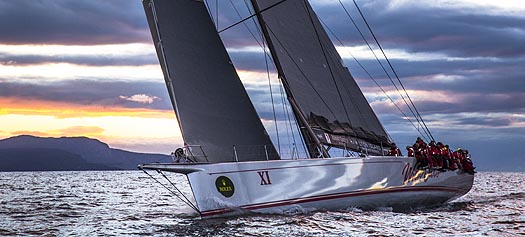
Wild Oats on track for the treble in the Rolex Sydney Hobart 2012. Photo: Daniel Forster/Rolex
SO FAREWELL THEN, EUROPEAN YEAR 2012 FOR ACTIVE AGEING AND SOLIDARITY BETWEEN GENERATIONS, AND HELLO TO THE GORB
Did you know that we've just lived through European Year 2012 for Active Ageing & Solidarity Between Generations? Me neither. And even if someone had told me, I'd have forgotten the beginning of a title of such length and contrivance before I'd even got through to the end.
May God in His Mercy protect us from well-meaning bureaucracies. We know that there are agencies in Brussels which make a tidy living out of putting an often costly structure on activities which any healthy local community would regard as so normal as to be scarcely worthy of comment. But the European Commission for Employment, Social Affairs, and Inclusion, with its European Year 2012 for AA & SBG, surely takes the biscuit.
The reason we've come across this absurdity is that in mid-November we received a news release from Brussels telling us that two Irish AA & SBG projects took second and third prize in a competition throughout Europe which attracted 1300 entries in six categories.
Millstreet Community School's Living Scenes programme, running for seven years, has seen retirees and teenagers "brainstorming together to come up with creative multi-media projects aimed at bridging the gap between young and old".
That won a second place in "Intergenerational Encounters", while third place in Journalism went to a four part RTE series about Age and the City, which we're assured was "highly entertaining for all ages".
This sort of thing is all very well, but is it life as we should know it? The whole business of ageing and retirement is built around chronological ageing, which misses the point entirely. It's what you do and how you feel that gives a much more accurate gauge of real age, rather than a sum of years. There's a large cohort of seniors out there who are so busy, so absorbed in getting on with multiple interests, that they would no more think of joining active ageing groups or taking part in formalized inter-generational encounters than they would contemplate no longer owning a boat, or not having a dog about the place.
Back in August I went cruising to the Western Isles in a hundred year old boat, and was Ship's Boy for a Skipper and First Mate who were both 74. But our doughty skipper belies all received opinion about ageing, as he looks after his high-maintenance old boat himself, plus he is also Senior Mechanic and Retrieval Driver for various vintage vehicles which his wife and daughter need for their string of show-jumpers.
As for the First Mate, he plays rugby for the Perennials, and just last winter the highlight of their season was a tour to the rugby paradise of Limerick. He reminisced during our cruise about the techniques required going shoulder-to-shoulder against Peter Clohessy – not an experience for the faint-hearted.
With this splendid double lineup of Active Ageing, I had to supply the Solidarity Between Generations, even if the Skipper was much more agile than the Ship's Boy. This was demonstrated when the Skipper became so irritated by the flapping of the leech of the high cut jib that, off the coast of Skye, he quickly climbed on the First Mate's shoulders in order to tension it.
There are some unkind people who suggest that if I was really interested in promoting Active Ageing, then I should have let fly the jib sheet while these venerable gymnasts were doing their thing. That undoubtedly would have added a certain je ne sais quoi to the performance. But instead I took a photo, for here indeed was something for Brussels' attention. If we're going to encourage active ageing, then we're going to have to accept that senior sailors are going to be clambering about on the broadest shoulders aboard in order to adjust the rig of their ancient boats. And we're going to have to accept that they're of a generation that regards safety harnesses and lifejackets as restrictive of movement.
So in the first instance, let Brussels commission us for a Feasibility Study for a GORB – a Golden Oldie Rescue Boat. This would follow the seniors about as they wander across the ocean, and gather them in when they fall off their own ancient craft. The GORB would need to be a proper cruising vessel, and as her crew would include a significant proportion of seniors, she in turn would need another GORB to follow her.
And another one again. We'd build up a fleet, eventually sailing round in a vast circle. We'll call it The Gathering Cruise.
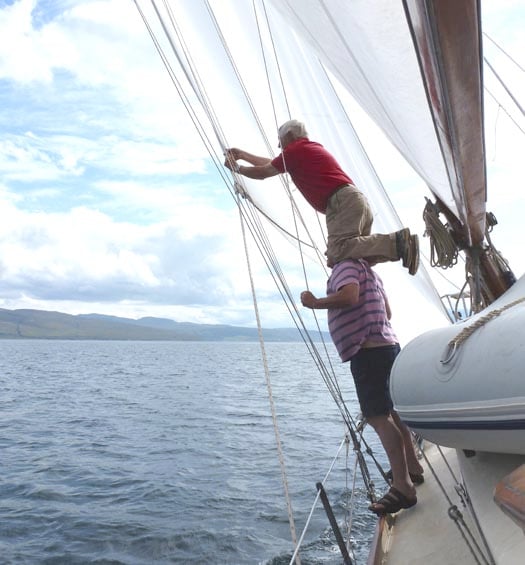
These guys need a GORB. The combined age of this acrobatic troupe is 148 years, with neither safety harness nor lifejacket in sight. Photo: W M Nixon
The 'National Awards to Volunteers in Irish Sports', held at the Aviva stadium celebrated the contributions of volunteers to Irish sport.
There are over 400,000 people throughout the country who voluntarily dedicate their time every year through their involvement with sports clubs and organisations. 250 volunteers were shortlisted, and Dun Laoghaire's Brian Craig was one of only eleven to receive the award from the Minister.
The national awards are an initiative of the Department of Transport, Tourism & Sport in conjunction with the Federation of Irish Sports, which represents some 68 sports in Ireland. The scheme is also supported by the Community Foundation of Ireland and the Irish Sports Council.
Attending the ceremony with Brian and his family was Irish Sailing Association (ISA) President, Niamh McCutcheon.
The award winners were selected by a committee chaired by Olympic Gold Medal Winner, Ronnie Delany, alongside representatives from the Federation of Irish Sports, Irish Sports Council, The Irish Times, RTÉ and the Department of Transport, Tourism & Sport.
Speaking at the presentation of the awards Minister Ring said. "The contribution of volunteers in supporting Irish sports people at every level, from when they first engage in sporting activity right through to developing elite athletes, should not be underestimated. Indeed, the army of volunteers who dedicate their time and commitment to each sport in Ireland assist in building strong and healthy communities, while giving everybody the opportunity to be the athletes they are."
"In presenting these awards today I wish to not only congratulate the 11 volunteers who truly deserve their honours, but I would also like to acknowledge all of the 400,000 people who help to ensure Irish sport is in such a healthy state. Quite simply sport in Ireland wouldn't function without their incredible efforts, and as a nation we would undoubtedly be worse off."
Sailing Body Elects First Female President
In one of her last official functions as Minister for Sport, outgoing local TD Mary Hanafin attended the Irish Sailing Association's annual Ball last Saturday in the Royal Marine Hotel in Dun Laoghaire.
Attended by 315 people the black tie ball featured an awards ceremony that has been hailed 'a great success' by the association.
On Saturday afternoon the association elected a new President, Niamh McCutcheon, the first female ISA President since the organisation was founded in 1945.
A collection in aid of the RNLI raised over €2,250.
Award details below:
ISA Sailing Achievement of the Year
This award is presented by the ISA to recognise the outstanding achievement in a sailing craft by an Irish person or in Ireland during 2010.
Winner: Nicholas 'Nin' O'Leary, Royal Cork Yacht Club
Nicholas' achievements included narrowly beating his father Anthony at the ISA All Ireland Championships in 2010 by just a single point after a nail-biting finale in difficult conditions off Kinsale in November. The win made it three-in-a-row for this remarkable young 24 year old sailor - the only person to achieve this in the 64 years of the event's history.
ISA Volunteer of the Year
This award is given to a member of an ISA affiliated club or class who has made a significant voluntary contribution to their sport during 2010.
Winner: Brian Craig, Royal St. George Yacht Club.
Brian has been nominated by the Royal St. George Yacht Club for the vital role he has played in developing sailing in Ireland and specifically Dun Laoghaire over the past 40 years. His most recent success was winning the bid for Dun Laoghaire to host the 2012 ISAF Youth Worlds.
ISA Youth Sailor of the Year
This award is presented by the ISA to recognise the outstanding achievement by a sailor competing in ISA Performance Pathway boats during 2010.
Winner: Finn Lynch, Blessington Sailing Club
Placing 2nd overall at the Topper World Championships in 2010 left the Carlow sailor in good stead for a Youth Sailor nomination. A determined sailor and strong character, it's clear that with these strengths Finn has the potential to go far in our sport.
ISA Instructor of the Year
This award recognises the role instructors have in providing access to our sports. The final 5 have been nominated by their students with the ultimate winner selected by an ISA judging panel.
Winner: Aine Carroll, Rush Sailing Club
Aine has been an ISA instructor for the last 11 years, instructing both adult and junior sailors in Rush Sailing Club. A keen Mermaid sailor, her love of sailing, her enthusiasm for the sport and willingness to give her time to her sailors have been infectious and remarkable. Apparently the kids at the club think she is a 'legend' and 'cool'!
ISA Training Centre of the Year
The face of ISA water sports to thousands of participants. The best in 2010 as nominated by their students.
Winner: University of Limerick Activity Centre
Situated on the sheltered shores of Lough Derg, University of Limerick Activity Centre has been in operation for over a decade. ULAC provides a varied programme of adventure activities to the general public. The University of Limerick Activity Centre runs ISA courses in sailing dinghies, windsurfers, powerboat as well as emergency care training courses.




























